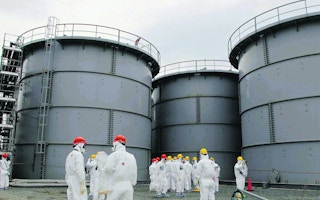Safety checks following the Fukushima disaster in Japan in March 2011, when a 10 metre-high sea wall was overtopped by a tsunami, have shown that nuclear plants are at greater risk of catastrophic flooding as a result of climate change.
All nuclear plants need large quantities of water for cooling so all must be built close to the sea, large rivers or lakes. This makes them vulnerable to sea level rise, storm surges and to the possible collapse of large dams upstream from poor construction, floodwater or seismic activity.
Since nuclear plants are designed to operate for as long as 60 years and need around a further century to decommission, accelerating sea level rise and more intense rainfall may present serious problems.
There are currently 435 operating nuclear reactors in the world, many of them potentially vulnerable to flooding because of natural disasters. Examples from the UK, Finland and the US show that the extent of the danger is not always being disclosed.
In Britain, after discovering in May 2013 that one of their reactors would be at risk during a storm of inundation by seawater, the owners, EDF Energy, quietly shut it down. The reactor, at Dungeness and built on a shingle beach beside the English Channel, supplies 750,000 homes.
“
The risk of a serious nuclear accident remains always above zero as a result of unexpected phenomena taking place.
Christer Pursianen, professor of societal safety and environment at the Arctic University of Norway
The company informed the Office for Nuclear Regulation that it was being shut down as a precaution. The reactor remained off-line until 15 October that year while a new sea wall was constructed – losing the company around £100 million in revenue.
Serious problem
Although the company did announce the closure at the time, the extent of the problem and the length of the shutdown were not announced. Later EDF admitted that the emergency works had taken place following an assessment of the flooding danger after the Fukushima disaster.
Stephen Thomas, professor of energy policy at the university of Greenwich in London, criticised EDF for its attitude. He was quoted by the UK’s Independent newspaper as saying: “If a plant closes for five months it is not just fiddling about, it is something serious, and EDF can’t pretend it is not…we need to be told the truth.”
The same fears were raised in the US by the Union of Concerned Scientists after a report was leaked about the danger to nuclear reactors from dams bursting. According to a report by the US Nuclear Regulatory Authority (NRC), which had been withheld, more than 30 nuclear installations were in danger from flooding. The Commission was later accused of using security concerns to mask embarrassing information.
Higher odds
Among many revelations in the report was the fact that the authorities had known for a decade or more that the failure of a dam upstream from the Oconee nuclear plant in South Carolina would cause floodwater to overwhelm its three reactors, possibly causing a catastrophic meltdown. The odds of the dam bursting were far higher than the chances of the accident that devastated Fukushima.
Oconee is one of the largest nuclear plants in America and has been operating since 1983. Its owner, Duke Energy, remains confident that it could shut the plant down safely in an hour, before floodwaters from upstream could reach the reactors. The NRC has decided that this is sufficient safeguard.
Dave Lochbaum, director of the Nuclear Safety Project at the Union of Concerned Scientists, said: “The NRC knows – and has known for many years – that flooding from dam failures can disable the emergency equipment needed to prevent reactor core meltdown.
“The agency must require plants to address known flooding hazards and thoroughly investigate other plants that may be at risk and require them to resolve any potential hazards.
“If such a flooding accident occurred, the NRC would quickly determine which other plants were vulnerable and require them to strengthen their protection against similar events. Wouldn’t it be smarter for the agency to do that before an accident occurs?”
More open about its problems is Finland’s Loviisa nuclear power plant on the Baltic Sea, which was flooded by a 1.73-metre storm surge in 2005. Since then four cooling towers have been built 10 metres above sea level to avoid inundation in a new storm surge, and new floodgates and waterproof doors have been installed to protect the reactor. A new road has been built above flood level so that emergency services can reach the plant to pump away floodwater.
Even so, the Rain Project, a consortium of experts on safety and climate change, thinks more can be done to protect against potential disaster. Christer Pursianen is professor of societal safety and environment at the Arctic University of Norway.
He says that although Finland is in the forefront of nuclear safety, more needs to be done to train staff in emergencies and to develop links with neighbouring countries so as to gain experience in disaster prevention: “The risk of a serious nuclear accident remains always above zero as a result of unexpected phenomena taking place.”










